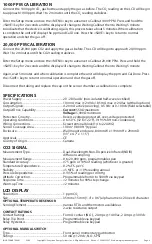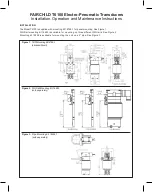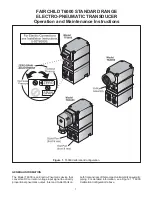
Page 2
Mount the base by screwing to an electrical box or directly to the wall as shown in Figure 4.
After the base is screwed to an electrical box or directly to the wall using the appropriate holes, remove the
PCB from the anti-static bag, feed connection wires through the center hole and place the top of the PCB
into the PCB holders on the backplate and snap the bottom of the PCB into place as shown in Figure 4.
Making wiring connections as per the Wiring Illustrations below and install the decorative cover by placing
the top of the cover into the cover holder on the top of the backplate and snapping the bottom into place
as shown in Figure 4. Tighten the security screw with a Phillips screwdriver.
WIRING
Deactivate the 24 Vac/dc power supply until all connections are made
to the device to prevent electrical shock or equipment damage. Follow
proper electrostatic discharge (ESD) handling procedures when installing
the device or equipment damage may occur. Use 22 AWG shielded
wiring for all connections and do not locate the device wires in the same
conduit with wiring used to supply inductive loads such as motors. Make
all connections in accordance with national and local codes.
This is a 3-wire sourcing device. Connect the plus dc or the ac voltage
hot side to the PWR terminal. The supply common is connected to the
COM terminal. The device is reverse voltage protected and will not
operate if connected backwards. It has a half-wave power supply so
the supply common is the same as the signal common. Several devices
may be connected to one power supply and the output signals all share
the same common. Use caution when grounding the secondary of a
transformer or when wiring multiple devices to ensure the ground point
is the same on all devices and the controller.
The analog output is available on the CO
2
terminal. This signal
is switch selectable for either voltage or 4-20 mA active output
as shown in Figure 7. In voltage mode the output is selectable
for either 0-5 or 0-10 Vdc later during the menu setup (the
factory default is 0-5 Vdc). The current output operates in the
active mode and does not require a loop power supply (the
signal current is generated by the transmitter and must not be
connected to a powered input or device damage will result).
Check the controller Analog Input to determine the proper
connection before applying power. Both current and voltage
signals are referenced to the COM terminal. The analog
output signal is typically connected directly to the Building
Automation System (B.A.S.) and used as a control parameter
or for logging purposes.
Figure 5
Figure 7
Figure 8
Figure 9
Figure 10
Figure 6
Power Supply
Wiring for voltage output signal
and 24 Vdc power from controller
Wiring for all output and external 24 Vac power
transformer or external 24 Vac power supply
CO
2
COM
PWR
N.O.
RELAY
S COM
SWITCH
+
-
CO
2
COM
PWR
0-5 or 0-10 Vdc AI
COMMON
+24 Vdc
COMMON
Digital Input
COMMON
Digital Input
Analog Input
COMMON
Analog Input
COMMON
COMMON
24 Vac
Controller
Alarm
Controller
Controller
24 Vac Transformer /
Power Supply
mA
VOLT
Current
4-20 mA
Voltage
0-5 or 0-10 Vdc
VOLT
mA
0001248
CO2 SENSOR
ROLL
SAVE
MENU
OVERRIDE
TEMP
CO2
COM
PWR
S COM
SWITCH
N.O.
RELAY
OUTPUT
mA
VOLT
SWITCH
TEMP
Copyright © Greystone Energy Systems, Inc. All Rights Reserved Phone: +1 506 853 3057 Web: www.greystoneenergy.com
IN-GE-CDD4B1XXX-01 05/20

























